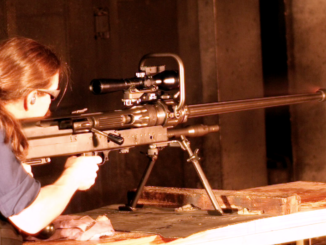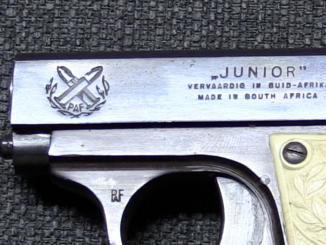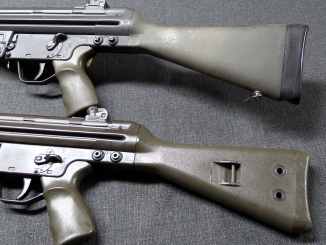This is your last chance to win this very rare Mamba pistol!
https://www.fanathem.com/forgottenweapons
DEADLINE to ENTER is TONIGHT 12/20/24 @11:59 PM PST
The Mamba was a pistol that had a pretty decent design, but failed because of incompetent manufacturing. Today we are taking a look at a handful of surviving Mambas including the only know Green Mamba, courtesy of Val Forgett at Navy Arms. In addition, we have the minutes of a June 13, 1978 meeting of the whole Mamba team along with the senior Forgett and his factory manager. Those minutes really shed some light on why the project failed so badly. You can download the PDF and read them in full yourself here:
Mamba production meeting minutes [PDF]
Full video on Mamba history and development:




Joe Hale sounds like managers I have worked for. Full on blowhards with failure after failure, which people never were willing to shut down. The blowhards just go from company to company, making tons of money for themselves, but never producing a solid product.
Bart
It sounds like the Dilbert principle working as it should
those who can; do
those who can’t; become managers.
it’s nature’s way of getting them out of the way of productive people.
It’s also one of the roles of new start up businesses and the state sector.
Everyone else strokes the egos of their own very worst employees and encourages them to let their skills and abilities shine in the shiny new jobs with the shiny new companies.
Anywhere you have a hierarchy, you’ve got what I’d term “hierarchists”, people who don’t specialize in doing what the hierarchy is supposed to be doing, but who are actually specializing in “working the hierarchy”.
Every organization we’ve ever built as human beings inevitably succumbs to this innate failure-mode: The hierarchists eventually wind up running everything, and then choke the whole enterprise to death.
The only really major enterprises that humanity has accomplished without this creeping idiocy destroying them were things like the apparent rise of modern humanity out of Africa, the colonization of the Pacific by the Polynesians, and the colonization of the Americas by the people who apparently arrived after whatever it was that happened at the end of the Younger Dryas. None of that occurred with any form of identifiable program/hierarchy: There was no Polynesian equivalent to NASA, there was no “North America Company” run by Siberian entrepreneurs… It was all just inchoate humanity doing what it does best, with little cellular band organizations competing with each other.
I’m going to go out on a limb here, and point out that this syndrome of ours is exactly why we put man on the Moon some sixty-odd years ago, and haven’t been back once since the original program ended. Granted, there’s some similarity to the way the Europeans colonized the Americas, with the lag time between initial voyage of discovery and actual exploitation, but… I blame the tendency towards promoting hierarchists at NASA, and the utter bullshit they brought in. We should have had orbital stations above Mars, by now… Certainly, we should have had ones around the Earth and Moon, with ground stations exploiting lunar resources.
Leave it to the short-sighted exploiters of the hierarchy? You’re going nowhere. Leave off with the hierarchy? You just may wind up running entire continents.
Organization and hierarchy are powerful tools; misused, they’re worse than useless.
Welcome to our new administration.
In the NASA example, I wonder: what the 1969 organization chart looks like in comparison to the current organization chart, and how many inches of 8.5×11 regulations governed programs in 1969 versus today?
Did you ever see that infamous wall chart of the military procurement process from awhile back?
Behold, the simplicity:
https://acqnotes.com/wp-content/uploads/2014/09/Interactive-Lifecycle-Wall-Chart-Jan-18.pdf
Marvel at the fact we get anything through that cluster-f*ck of a “system”. Further, be amazed that things don’t cost ten times what they do, given all the paperwork required, and how many parasitic loads there are on the entire system. There are people whose entire careers have been devoted to filling out forms for this process…
It’s my guess that if we’d had this implemented during WWII, the Sherman tank might have been ready by about 1970… Fuggedaboudit, when asking for the B-29 or the atomic bomb.
That is an atrocity.
Created for you by the ohsoverybrilliant men and women we’ve elevated to positions of power within the Defense Department. They all did really, really well on all the tests, passed all the selection criteria, and they’re utterly brilliant.
Just ask them.
Speaking as one of their erstwhile vic… Er, subordinates, you’ll have to forgive me for having developed a deep and lasting cynicism about their inherent wisdom. Also, innumerable tics and twitches that show up whenever I start hearing about how great our senior leadership is…
Don’t even get me started on the current team!
That says it all, and makes complete sense.
Verbatum technical meeting minutes! I’m very impressed. It takes a particular set of skills to follow and transcribe flowing conversations. Sometimes a strong personality’s voice will be heard more than the softer one.
The stenographers that are capable certainly earn the big shekels…i was married to one in another lifetime.
According to https://en.wikipedia.org/wiki/File:Stenotype_advertisement.jpg
EARN BIG PAY IN AN EXCITING CAREER!
Put yourself in the center of important events. Learn at home to become a
Stenotype (MACHINE SHORTHAND) Operator
Easy to learn even if you’ve never taken shorthand before!
Step up from routine office work into a glamour job where the pay is far above the average. Sit beside top corporation executives at board meetings and big conferences. Even cover conventions and courtroom trials!…
The whole thing just goes to show… Making guns is hard, ‘mmkay?
I used to know one of the guys who’d been heavily involved with Detonics, back when it was just a side-operation of a good-sized aviation machine shop. The stories he had to tell about all that, and what a pain in the ass the whole thing really was, especially in relation to the stainless steel… It was illuminating, and I’ve had an appreciation for just how hard it is to get even a well-understood design into mass production.
As an aside… Has anyone ever looked at actually using the galling effect as an intentional part of design? Is it predictable and consistent enough to do that…?
Only such thing I can think of might be the Blish Lock. Anything else out there that Daweo might turn up? 😉
IIRC, the Kimball automatic in .30 Carbine was initially designed to use galling as part of its theoretically delayed-blowback action. Specifically, the slide rails and the slide were supposed to interact much like the “slide” under a Dahlgren smoothbore on a slide carriage on a barbette mount during the American Civil War. Disregarding that the friction on that could be adjusted ad hoc with the “compressor”- or just a bucket of sand.
It didn’t work, hence the Kimball’s famous “striated” or “serrated” chamber walls to grip the cartridge case until chamber pressure dropped to a safe level for extraction and ejection. That didn’t work too well, either, resulting in at least three and possibly four different patterns of chamber-wall “striation” during the Kimball’s very short production run.
I would put “galling” down as a phenomenon too variable to be much use in a practical sense, and just annoying enough as a wear-inducer to make any sensible designer be very cautious in their choice of alloys and etc.
clear ether
eon
“(…)anyone ever looked at actually using the galling effect as an intentional part of design?(…)”
Do not underestimate inventors securing U.S. patents namely Russell L Hohl
US2073278A Mounting device from 1936
…1. In an article of the character described, complementary backing and finishing parts cooperative -for mounting one upon the other, and having for the purpose longitudinally extending tongue and channel members with side faces proportioned and arranged to have frictional interengagement in parallel planes, at least one of said members being of suillciently soft material such as aluminum and at least one of each interengaging pair of said faces having such deformations that said interengagement will be accompanied by galling of at least one of the faces of each pair in assembly of the parts…
US2182434A Illuminating device from 1936
…due to the galling action between the side walls of the groove 89 and the rib I03, the parts are held securely in assembled relation…
(numbers reflect parts at attached drawing)
Both available in full
https://patents.google.com/patent/US2073278A
https://patents.google.com/patent/US2182434A
there is (?was?) a little business jet that’s aluminium skin panels were bonded by a friction welded process, that looked a bit like end milling with a blunt cutter.
I can’t remember the plane’s name, Bruce Dickinson (Iron Maiden front man) had a business selling them in Britain about 10 years ago.
back in the early eighties, I saw and heard of a few more tales of stainless 1911 clones with their slides seized solid on the rails
one in particular, I think it was a Safari Arms, the guy had thought because it was stainless it wouldn’t need any oil on it.
Thinking about possible ways to free it up that are more gentle than just soaking it in oil and beating it free with a drift to avoid marring the surface, brings up another hidden peril of stainless.
The martensitic (hardenable) stainless steels undergo a brittle transition at around room temperature.
It might not appreciate time in the freezer, followed by dipping the slide into something hot.
S&W designers stated that a typical stainless-steel pistol such as the 645 would have anywhere up to a dozen different stainless-steel alloys in it, specifically to prevent that.
They had to develop entirely new stainless-steel alloys for the Model 500 revolver. Less to handle the pressures than to avoid seizing when thing warmed up inside due to repeat firing.
This is something to think about when the question “Why don’t military rifles and MGs have all-stainless steel mechanisms?” comes up.
I suspect it would be entirely possible to build something like an M240 out of stainless alloys- and end up with a single GPMG costing slightly more than an IFV.
clear ether
eon
It’s a fair point, that. I also suspect that there are issues with “We’ve always done it that way…” going on, because there’s a notable lack of any real use of things like Tenifer in military use, which a rational person would look at and say “Hey… Why haven’t they updated the TDP to reflect modern coatings and materials…?”
Big Army is still specifying button-broach barrels on legacy weapons, despite FN offering them the superior CHF technology. Only the M4A1 takes advantage of the increase in barrel life and abuse, because that weapon came out of SOCOM and their separate procurement/design pipeline. Mainstream M1 and M4 production for Big Army? LOL… Not even looked at: If it was good enough for Grampa back in the 1960s, it’s good enough for us now.
“(…)Mainstream M1(…)”
What is this?
Should be “Mainstream M16”.
If you go looking, the specs on the actual TDP are unchanged since the original procurement. FN wanted to update a bunch of things like coatings and materials, but… No can do; TDP was frozen. So… Instead of the superior CHF barrels that FN was making for all the M249s, which were damn near sniper-grade, they had to buy the button-broach machinery and produce their M16A2 versions with those barrels. Which, I understand, was one reason that their early production earned an abysmal reputation for accuracy and “issues”. Later ones were much better…
Kirk;
The punch line is that typical commercial 1:9″ twist 16.5″ “carbine” barrels for ARs are CHF-machined, because it’s actually cheaper than doing it “the old-fashioned way”.
And unlike Ord, commercial manufacturers have to actually make a profit on each item going out the door.
cheers
eon
@eon,
The thing a lot of people never seem to quite wrap their heads around is that “MILSPEC” isn’t necessarily “Best”. It’s far more often a minimum standard, a floor. While in some cases, that might be higher-quality than pure bargain basement, you have to also consider that it’s very much the bare minimum in the majority.
I was talking to an aviation engineer, once upon a time. He was bitching about some issue over at his subcontracting job that was doing stuff for Boeing, and he was livid about how someone in the company had missed that a run of parts was supposed to be built to a specific Boeing standard, and that they’d only inspected for a routine MILSPEC one.
Which naturally raised a question in my mind, because I was often flying around in those “perfectly good” Air Force aircraft and the occasional Army airframe, as well. What he told me was illuminating; apparently, in a lot of cases, a specific MILSPEC specification takes a bunch of things into account, like… Is this part really required to last through X number of duty cycles, or do we expect it to fail about the time something else does? So, yeah… You’re good to go if all the parts are of similar vintage, but if the guy doing the work either didn’t have or didn’t bother to replace that other part whose lifespan was balanced against this one over here…? Yeah; plane go “BOOM”.
There’s also a certain triage going on, which anyone familiar with Soviet military engineering will likely recognize: If whatever it is belongs on a weapon, vehicle, or aircraft whose lifespan is predictably short due to combat losses, why bother going to the trouble of giving that part the amount of attention and quality control that would make its lifespan greater than the expected life of the weapon…?
Think about those cruise missile jet engines, as an example. They put just enough effort and quality into those to enable them to reliably do that one flight, but no more. Not worth the effort or resources…
So, if you repurpose your itty-bitty jet engine that you got surplus from the Tomahawk program, ya might want to think about going through it with a fine-toothed comb if you’re planning on putting it into your little homebuilt aircraft that you plan on flying… There was a hours-based lifespan specified in that thing’s governing MILSPEC document, and you really don’t want to trust it past that point. Triage was performed, somewhere along the line…
@Kirk
The prescriptive spec rather than a performance spec
(eg >95% of barrels drawn at random at a number of N per ten thousand, will achieve >95% of shots inside a circle of x inches, following Y thousand shots fired over the firing schedule with ammunition specified in appendix Z)
really is a hallmark christmas card of bureaucratic hubris
that a bureautwat sat in an office thinks he knows more about how to make machinegun barrels than the guys at FN, H&K, CZ etc.
IIRC, service life of a tomahawk engine was about 5 or 7 hours.
I suspect that a lot of that short life will be things like creep deformation in the first stage turbine blades, and fatigue life in the compressor fan blades.
possibly also things like roller bearings that are smaller than they would need to be for a longer life, but were chosen that size to save weight.
anyone who wanted to re use one of those engines would need to know exactly what they were doing
it may be that they’re not useable for any projects that require a longer life, or that they need to be downrated so far that they don’t offer any advantages over normal commercial small jet engines, for example out of airliner auxiliary power units.
Any chance of seeing one of these fired?
Yes: https://youtu.be/p3SdYwN-Emo
I remember the Mamba and its advertising. The only “selling point” it ever had was that it was made in Rhodesia or apartheid South Africa. Even a working one wasn’t better in any way than several established pistols from experienced manufacturers.
Racism fans, like eco – tourists, aren’t much of a customer base once you get past bumper stickers.
I am a racist. But I am also bright enough to buy on the basis of quality and track record.
it was advertised on the back cover of (I think) gun digest, the monthly, about 1979. I remember the ad, anyway.
CG